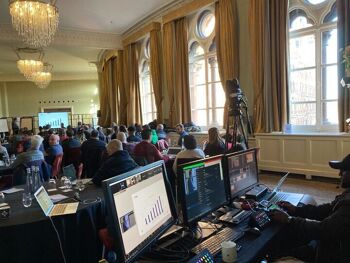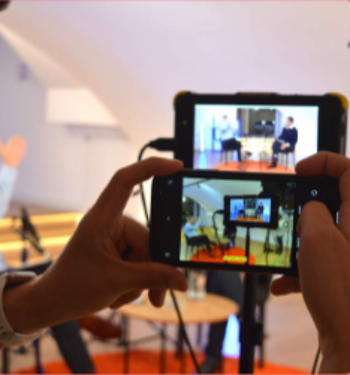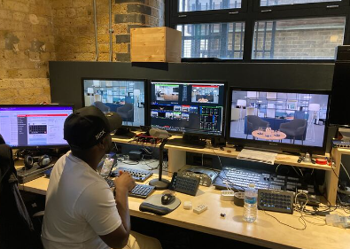11 steps to help your business transition from physical events to virtual events
As we find ourselves adapting to the new normal that has taken shape as a result of the coronavirus, virtual events are a great way to bring your otherwise cancelled event back to life. From live concerts to conferences, according to Forbes, virtual events are up by 1000% since the start of the pandemic.
With expos, conferences and shows getting cancelled or postponed, pivoting to virtual events is a fantastic way to maintain your connection with your audiences and ensure that your business still generates revenue. These are fantastic alternatives to physical events, and can work just as well in engaging your audiences.
Faced with the impact of Covid-19 and a government lockdown, the events team at New Scientist could no longer run physical events. Their event revenues zeroed overnight, with all of their events until June cancelled. However, the team saw this as an opportunity to pursue virtual events as an alternative way of hosting their lectures. Working with our team at Bombora, the New Scientist events were brought back to life in the form of online events. For New Scientist, this proved to be a great success, showing that they could generate revenue through their online talks.
If you’re looking to pivot towards virtual events, we’ve made a step by step guide to ease your way into the process of transitioning away from physical events and towards online events.
Following the steps listed below will help you to organise a virtual event seamlessly:
- Assess your goals and talk to your audience
- Plan meticulously
- Choose your streaming platform
- Consider extra virtual experiences
- Organise a networking space
- Optimise your content for online engagement
- Practice your presentation
- Technical run through
- Prepare for potential technical challenges
- Promote your event
- Measure your impact and apply your learnings
1) Assess your goals and talk to your audience
The first and crucial step to consider before planning your virtual event is to assess your goals. Think about your target audience and what you would like to achieve from your virtual event.
A great way to do this is by actually reaching out to your existing audience for your physical events. New Scientist’s events director, Adrian Newton, shared that their team sent surveys to their current audience, asking about what they would like to see in a virtual event. They found that their audience was keen on keeping with their existing format of lecture-style events with scientific experts, and this informed their approach to their virtual events.
By actually speaking to your viewers you can better understand how to organise your virtual event. Ask them about what format they’d like to see and the kind of content that they’re interested in to build a strong foundation for a successful virtual event. For some ideas on which format might work for your virtual event, check out our article on webinar formats.
2) Plan meticulously
Planning for a virtual event involves a similar process to planning a physical event. Just like a physical event, you’ll need to consider your guest speakers, any potential sponsors and the schedule for the event itself. An important consideration is also whether or not you’re planning to charge for tickets to attend the event itself, and the process of monetisation.
If you’ve already planned your physical event and are looking to directly transform it into a virtual event, think about what might need to be done to achieve this. With online event platforms now offering options such as sponsorship booths, virtual lobbies and breakout rooms, you should think about how you might be able to use this for your own event. These features will help you bring your event to life and more easily replicate a physical event.
When working with external guests such as sponsors and outside speakers, you will need to plan if any coaching sessions will be required. As virtual events are still relatively new, you should make sure that everyone involved is comfortable with how the day will run.
If your event is set to be on a larger scale, it is worthwhile to consider organising a team of people who can be on hand to ensure that the day runs smoothly. You can choose to hire a virtual events specialist, or make use of your business’s internal tech team. Whatever you decide, make sure that this team really knows the ins and out of the event and fully understands how the online event will run.
3) Choose your virtual event platform
Choosing the right streaming platform for your virtual event is important to ensuring that your event runs smoothly. Spend time assessing your different options and think about what features you’d like to prioritise for your event. At the very basic level you should consider audience capacity, interactive features and branding and customizability.
However, if you’re really looking to elevate your online event, you should think about the more exciting additional features such as:
- Event booths – these are a great way to involve sponsors for your event and offer your audience a chance to speak to sponsors
- Networking opportunities – breakout rooms and lounges offer your attendees the opportunity to network and open dialogue with other attendees, similar to a physical event
- Virtual lobby – an interactive online lobby can help to imitate the same atmosphere as a physical event
- Breakout sessions – these offer another fantastic opportunity to foster discussion during longer talks and keynote presentations
- Payment integration – this a great feature to consider if you’re looking to charge ticket fees for your online event
Think carefully about your aims from the initial planning process and apply this to your research into streaming platforms. For New Scientist, choosing the right platform was important as it ensured that they could maintain the same quality of their events. With the right platform they were able to have their lectures run smoothly and have interactive features which engaged with the audience.
4) Consider extra virtual experiences
Virtual experiences are a fantastic way to enhance your event. A whole variety of digital experiences add an element of interactivity and can help bring your virtual event to life. Your attendees can feel like they are more involved in your event with experiences such as games and wine and beer tastings bridging the gap between online and in-person. These could be a fun way to make networking sessions more sociable and interactive.
Another way to really involve your audience is to include AR (augmented reality) and VR (virtual reality) experiences. These can bring a new level of immersion and interactivity to your event and place your audience right at the centre of the action.
Whether you choose to include these additional experiences is entirely dependent on the type of virtual event that you are hosting, and your budget. Of course, your event can still be great without these extra features but they are certainly something to consider during the planning process.
5) Organise a networking space
A key element of most large scale events is the networking opportunity. As mentioned in the previous step, some platforms do offer a virtual networking space. Whether your networking space will be integrated into your virtual event itself, or whether you decide to make a separate discussion board for networking, this space is really important to foster conversations like those that would take place at a physical event.
Think about whether you’d like to offer the opportunity to have video networking sessions, using tools such as Zoom. Face-to-face discussions are a fantastic way to emulate the in-person meeting. Equally, your attendees might prefer to only speak online. Either way, it’s a good idea to consider the various options and think about what networking spaces you’d like to make available to your attendees.
6) Optimise your content for online engagement
As virtual events don’t bring the same atmosphere and buzz of physically attending an event, it’s important to capture your audience’s interests with engaging content that translates well virtually. This can include strong slideshows, infographics, 2D and 3D animations and pre-recorded videos. Pre-recorded videos are an especially great tool which can be used in a variety of ways – consider creating a welcome video for the beginning of the event, or even video demos to use within your presentation.
When used correctly, your additional content can be a great way to illustrate your points. Make sure that the additional assets you create for your virtual event help you to tell your story and really grab your viewers’ attention.
7) Practice your presentation
Whether you’ve chosen to speak at your virtual event or have brought in an external speaker, the presentation should be practiced beforehand. Speaking on camera poses different challenges to speaking to an audience so make sure that your guests are comfortable with presenting on camera, or a webcam at home. Like a regular presentation, it’s important to speak clearly and concisely.
However, unlike a physical event, it’s also important to become familiar with the camera. Speak directly to the camera like you would with a member of the audience to establish a personal connection with your virtual viewers. Maintaining eye contact with the camera is a great way to appear confident and knowledgeable when delivering your presentation. Another way to really engage with your audience is to refer to your presentation
Think about body language as well: are you staying too still and appearing stiff? Or are you moving around too much? Try to strike a balance to help you come across as relaxed and confident.
If you’re speaking as part of a panel discussion, ensure that all the other speakers are comfortable with the interactions too. Ensure that you actively engage and listen to your other panellists and look at them on your screen as they’re speaking. The same applies if you’re going to include audience participation, with attendees also speaking on camera. This will help the conversation to flow organically, as if speaking in person.
Ultimately, practice makes perfect, so it’s crucial that you really spend time nailing your presentation. If you’re looking for more tips on how to present on camera, check out our tips on how to be a great speaker.
8) Host a technical rehearsal
Just like a physical event, it’s a great idea to have a tech rehearsal for your virtual event. Make sure that everyone who is going to be presenting or speaking during your event attends a trial session so that you can address any technical issues.
Things to test when you’re doing your practice run-through include the internet connection of all your speakers, the microphone and camera quality. Ensure that your speakers are all able to communicate easily during this practice session and address any internet delays before the day of your event.
At this point you should also check that any additional content assets – such as in-show videos, animations and slides – can be inserted easily into your event and transitioned smoothly.
9) Prepare for potential technical challenges
Remember that technical issues can happen to anyone, regardless of perfect internet connection and camera quality, so this is a good opportunity to anticipate any potential troubles that may arise during your live event. For these situations, prepare for any queries that your audience may have and consider having a member of your team on standby to help with any technical glitches that might come about on the day.
10) Promote your event
Promoting your online event is just as important as promoting a physical event. Develop branding and promotional materials for sharing online. This can include email newsletters, social media posts, and paid advertising. Consider how you typically communicate with your audiences for physical events and use these channels to connect with them to promote your virtual event.
If you have already interacted with them in the first step of this process, by sending a survey, you can build on this existing conversation and give them an event to look forward to.
11) Measure your impact and apply your learnings
Both during and after your virtual event, it’s important to track audience engagement and measure the effectiveness of your event.
Using key performance indicators you can assess whether you achieved your initial goals set out at the beginning. These can include:
- Number of registrations
- Number of live attendees
- Number of on-demand attendees
- Number of live questions sent in
- Audience interactions
You can also create a survey for your audience to fill out after to gauge their response to your virtual event. Ask them about the content of your event, the format and find ways to improve. Applying these insights will enable you to adapt your approach and enhance your next virtual event. New Scientist found that their post event surveys were helpful in generating a net promoter score (NPS) for their events, which provided a positive indication of how their events were received by their audience.
Ultimately, pivoting towards virtual events is the perfect way to rescue your revenues for the foreseeable future. As we become more accustomed to working from home and live streaming content, audiences are increasingly happy to attend virtual events. By embracing this new virtual landscape, you can keep your audience engaged and entertained in a dynamic new way.
Enjoy that? You might like these:





How Live Event Agencies Can Maximise Your Marketing Objectives






